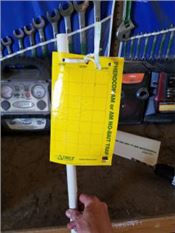Western Corn Rootworm: Adult Sampling And Economic Thresholds
DR. NICK SEITER, DR. JOE SPENCER, AND KELLY ESTES
URBANA, ILL.
Based on degree day accumulations, western corn rootworm egg hatch should be underway in much of Illinois (roughly south of Peoria as of May 29; you can view your specific location using the degree day calculator here: https://www.isws.illinois.edu/warm/pestdata/sqlchoose1.asp). We are probably just over a month away from seeing the emergence of the first adult beetles. With low rootworm populations for the last several years, there has been a renewed interest in adult sampling. The only way to determine if larval densities will be high enough to justify a control action in a specific cornfield next spring is to monitor adults in the field this summer. Doing this correctly will require some preparation to obtain the correct materials. Now is a good time to review your monitoring procedures for western corn rootworm adults.
The most common monitoring tool for western corn rootworm adults is a 5.5 × 9-in yellow card trap coated in sticky material (e.g., Pherocon® AM No-Bait trap, Trécé, Inc., Adair, OK). The yellow color attracts the beetles, and when they land on the sticky substance they become trapped (Fig. 1). We recommend placing 12 of these traps uniformly throughout each field that you are monitoring beginning in late July. If the field you are monitoring is planted to corn this season (i.e., continuous corn), simply place each trap on a corn plant just above an ear. If you are monitoring a soybean field this season that will be rotated to corn next year, you will need to place each trap on a stake so that it will sit just above the soybean canopy. PVC pipes (½” diameter) are a relatively cheap and easy material that you can use to make these stakes, but wooden, metal, or plastic stakes also work. Use poles that are long enough to allow trap height to be raised as the soybean crop grows taller. Replace each trap once a week for 3-4 weeks, count all western corn rootworm adults stuck to the trap upon collection, and determine the average number of adults collected per trap per day.
We recommend using the economic thresholds recently updated by our colleagues at Iowa State University [1] to determine if a control action is needed in corn the following spring (Table 1). If the beetle numbers you see on your traps are above these thresholds, a corn hybrid with Bt traits targeting corn rootworm or a soil insecticide is justified in that field when corn is planted the following spring. While monitoring for western corn rootworm takes some effort, it is the only way to get field-specific information on the economic need for a control tactic the following year. ∆
DR. NICK SEITER, DR. JOE SPENCER, AND KELLY ESTES: University of Illinois

Figure 1. Yellow sticky card trap used to monitor western corn
rootworm adults.
Economic thresholds for western corn rootworm
in continuous or rotated corn.
Sticky Trap Location Economic Threshold
Corn (continuous corn) 2 beetles per trap per day
Soybean (rotated corn) 1.5 beetles per trap per day